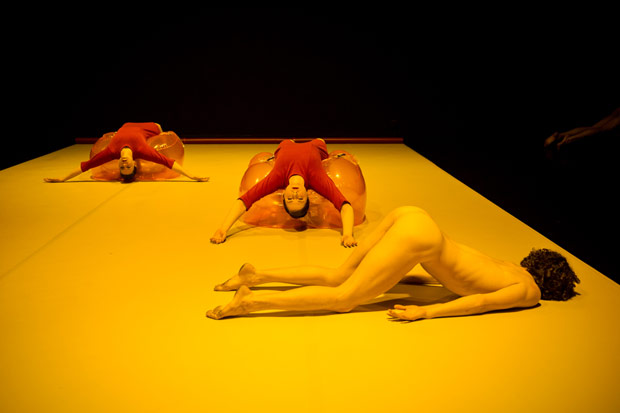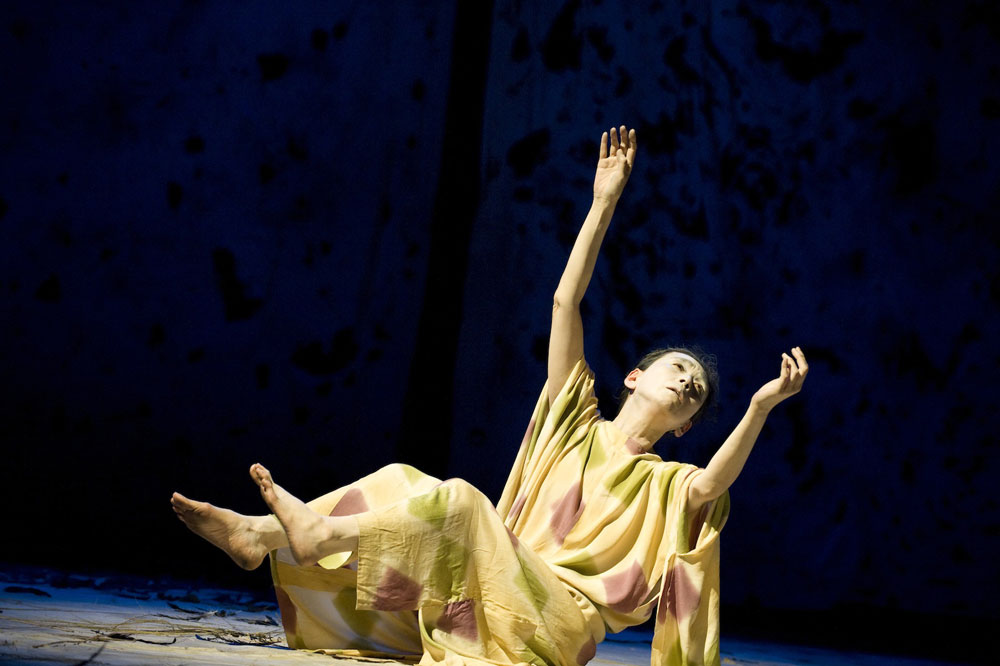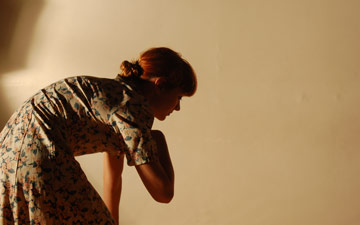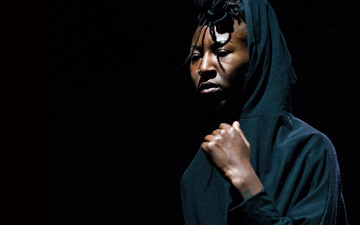
dancers (l-r): Lindsay Clark, Michelle Boulé and Ben Asriel.
© Ian Douglas. (Click image for larger version)
Regarding the Body: John Jasperse’s Fort Blossom Revisited and Eiko and Koma at Focus Dance
Focus Dance: Eiko and Koma and John Jasperse Projects, Mixed Bill
Eiko and Koma: White Dance, Flower Dance
John Jasperse Projects: Fort Blossom Revisited
New York, Joyce Theater
12 January 2013
www.eikoandkoma.org
johnjasperse.org
www.focusdance.us
www.joyce.org
New York is abuzz with performances after the holiday break, when one could practically see tumbleweed rolling down certain blocks on Broadway. A flurry of dance showcases has been timed to coincide with the yearly conference of performing arts presenters (APAP), which brings an army of eager scouts into the city’s theatres. Today’s mixed bill – the Japanese duo Eiko and Koma in the first half of the program, followed by John Jasperse Projects – was part of Focus Dance, one of several festivals catering to out-of-town theatre representatives looking for something to sell to audiences back home.
The Saturday afternoon performance at the Joyce was also an opportunity to catch up on Fort Blossom Revisited, the revival of John Jasperse’s 2000 quartet. Jasperse, a respected experimentalist who has been working in New York since the mid-eighties, revived the piece last year. There has been a lot of talk about its central duet for two nude male dancers (Ben Asriel and Burr Johnson). Throughout, they remain in constant and extraordinarily intimate contact. As the piece begins, they are drawn toward each other by a kind of immutable force; one rolls downstage, the other slithers across to meet him, posterior rising and falling, legs dragging behind him. From then on, the two lock together as if never to part. No corner of their bodies remains unexplored, most especially the crease between the buttocks (forgive my explicitness, but it is so). Practitioners of ballet often speak of a dancer’s “line” and the way two dancers complement each other’s lines in space. Here, “line” takes on quite different meaning: the line dividing the buttocks is the constant reference point, the home base for Jasperse’s explorations of the many ways two male bodies fit together.
This physical crease is the dancers’ primary area of contact, replacing the more familiar use of the arms and hands in a conventional duet. One dancer slithers the crease along the surface of the other man’s leg, arm, back, foot, and not infrequently, his face, neck, shoulder. The slight indentation between the buttocks steadies the other man’s body when it balances across his back; it provides a pushing off point and a guide for the other man’s movements. It is the hinge, the starting point, the constant focus of attention. Nothing is hidden except that spot concealed beyond the folds of creamy skin, the locus of lovemaking. The choreographer alludes to this most private of acts in a sequence in which one man lies on top of the other, separated by a slowly deflating clear plastic pillow. The two men’s pelvises move in sync, rhythmically, until finally they simply lie there, vulnerable and inert.

© John Jasperse. (Click image for larger version)
It’s surprising what little pleasure (or displeasure) there is in all this accumulated intimacy. The two men’s coupling is dispassionate, exploratory; it contains less ardor or erotic charge than one would expect. After a while, the nakedness almost disappears; the bodies become abstracted forms. Once in a while, Jasperse reminds us of what we are seeing, by having one of the dancers, say, spread his legs wide, so we cannot avoid the very concrete evidence of his anatomy. Johnson and Asriel are beautiful men, lean, tall, smooth-skinned, and Jasperse has put their physical grace to use. Their bodies interlock in intriguing ways. But I found my attention wandering. Should I have been more shocked or moved? The two dancers looked at each other only once. Without a gaze, it turns out, a body is just a body.
During most of this very explicit duet, the two women – Lindsay Clark and Michelle Boul – lie prone on the other side of the stage, on their stomachs, waiting to move. Unlike the men, their bodies were sheathed in knee-length, high-necked red dresses, as if Jasperse had decided their bodies simply didn’t matter. They wore the same neutral, blank expressions as the men. The score, by Ryoji Ikeda, was as impersonal as the dancers’ stares, with long silences punctuated by buzzing and thumping that sounded like a dryer at full tilt. The lighting, too, was uncompromising, I would say ugly: orangish on the women’s side, pasty fluorescent on the men’s. For the most part the sexes were separated, the women executing simple, highly formal phrases in unison with methodical precision while wearing large, orange-tinted inflatable pillows on their backs. Toward the end the two pairs finally converged. There was a moment of euphoria, accompanied by hyped-up Brazilian samba; the dancers flung themselves against the plastic balloons and then tossed them into the air, but the joviality seemed forced, unconvincing. Most of all, the piece simply felt too long.

© Anna Lee Campbell. (Click image for larger version)
In the first half of the program, the Japanese artists Eiko and Koma (now based in New York) presented two duets, the classic White Dance (from 1976) and a new work, Flower Dance. The couple has an almost uncanny physical affinity and a well-honed style, closely related to the Japanese postwar form known as Butoh. They have been working together since 1972. For the most part, they create stage pictures that evoke physical and mental anguish. Covered in white body-paint, hair unkempt, they are like figures in a Bosch painting, not quite human, not quite of this world. Their faces are masks, Eiko’s frozen in an open-mouthed grimace of sadness, Koma’s more clown-like and mobile. The two dances they performed were dramatizations of collapse, illustrations of the struggle for salvation and companionship, visions of bodies in crisis. The collapse of the body was depicted with extreme deliberateness; Eiko, in particular, can hold an extremely uncomfortable position for minutes at a time. The physical control and self-abnegation is quite astonishing. Koma is more unpredictable; he is prone to sudden outbursts of near-violence, kicking his partner to the floor or pressing against her like an animal, his face contorting grotesquely. He staggers and stomps like a bear or a wounded ox. Eiko and Koma’s style has not changed much over the years. There is something both comforting and stifling about this immutability. It’s as if they had been stuck in a silent scream for most of their waking lives. They are now in their sixties. What stays with you is the image of those bodies, tormented, trembling, vulnerable, but ultimately indestructible.

















You must be logged in to post a comment.